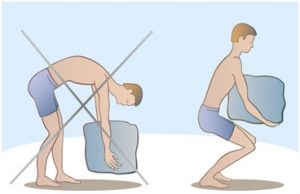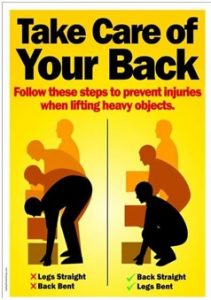Lifting is a common risk factor for the development of low back pain (LBP) and for decades it has been believed that lifting with a flexed lumbar spine was the cause.

Thousands of information pamphlets and educational wall posters have been distributed in order to educate warehouse workers, nurses and the general public to avoid lifting with a bent spine. It was a well accepted “fact” that by maintaining a neutral or a lordotic lumbar position, the risk of LBP is reduced during lifting.
There is no doubt that repeated heavy lifting is a risk factor for the development and the exacerbation of LBP, but what is questioned here is if the position of lumbar spine is a relevant factor while lifting.
The straight-back lifting advice has been based on cadaveric studies that found that the lumbar spine was more vulnerable with repeated end range flexion. However, is it not time to question the value of cadaveric studies?
Studies on live humans now show that lifting with either flexed or “straight” lumbar spine result in similar loads on the spine. In other words, compared to neutral spine lifting, lifting with a flexed spine does not seem to increase disc pressure, compression, or shear strain.
“No study that has directly measured the lumbar spine during lifting has found a relationship between LBP and greater lumbar flexion.” – Saraceni et al, 2020
This recent 2020 systematic review with meta-analysis (published in the J Orthop Sports Phys Ther) evaluated whether lumbar spine flexion during lifting was a risk factor for LBP.
Conclusion: “…greater lumbar spine flexion during lifting was not a risk factor for LBP onset/persistence or a differentiator of people with and without LBP.” – Saraceni et al, 2020
“… people with LBP lifted with 6.0° less lumbar flexion than people without LBP”. – Saraceni et al, 2020
This reduced lumbar flexion may be hypothesized to be related to fear, pain or previous education received from various health care providers.
One may argue, what’s the harm in teaching people to maintain a straight spine and to avoid flexion while lifting? There is in fact great potential harm as fear and catastrophization are the leading risk factors to the development of chronic LBP.
Clinical Relevance: Let’s be humble and accept that for decades we were wrong. What was taught to us about the spine was based on poorly interpreted cadaveric studies. Decades of educating the public and patients on “proper” lifting techniques seem to have had no effect on the prevalence of LBP. The time has come where we MUST consider other far more important factors that contribute to the development and the maintenance of LBP and shift focus away from fixing the exact angle of the spine while lifting. The mark of science is to admit failure and try a different approach.

It’s time to move forward and remove these well-intentioned posters demonstrating “proper lifting”. They may be contributing to patients’ beliefs that the spine is fragile and that the wrong movements or too much bending can easily damage their spine …further perpetuating fear & pain!

